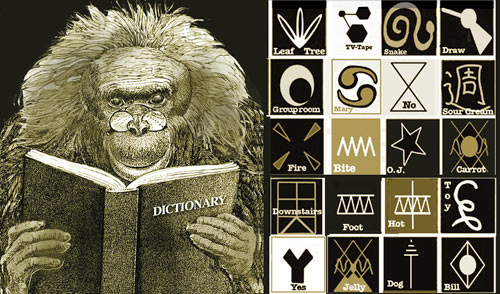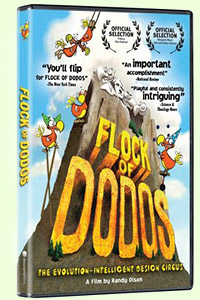
the next lecture in our fall season…
The Breathtaking Inanity of Flood Geology:
Geology, Creationism & Evolution
with Dr. Donald Prothero
Sunday, November 11th, 2pm
Baxter Lecture Hall, Caltech
Have you ever had to deal with a Creationist who takes the Genesis accounts literally, and who insists that the biblical story of Noah’s flood can account for all the geologic features of the earth, as well as all the creatures that survived on the ark? In this lecture, Dr. Prothero will not only discuss the biblical and logistical problems with “flood geology,” but also show how creationists’ conception of the geologic record would mean that we would never find coal, oil, gas or other natural resources that our society needs. In this engaging and richly illustrated lecture, based on his new book, Dr. Donald Prothero — one of the world’s most respected paleontologists — will provide a wealth of evidence and answers to creationist challenges to science. If you are interested in defending science education don’t miss this entertaining and though intellectually rigorous history of the geological and fossil record.
Important ticket information
Tickets are first come first served at the door. Sorry, no advance ticket sales for this lecture. Seating is limited. Notice to our regular lecture goers: we have raised our prices for the first time in 15 years. $8 Skeptics Society members & Caltech/JPL Community; $10 General Public.
With the recent death of Alex, the talking parrot, the debate about whether animals have language has once again moved into the public arena, so I thought it was time for Skeptic to revisit the subject in this article by Dr. Clive Wynne, a psychology professor at the University of Florida and the author of the authoritative textbook on the subject of animal cognition.

These drawings are of some of the symbols used by researchers to communicate with bonobo apes. The originals are in bright primary colors. View more symbols used to communicate with apes and see an interactive board on the website of the Great Ape Trust of Iowa.
Aping Language
a skeptical analysis of the evidence
for nonhuman primate language
by Clive Wynne
In August 1969 the pre-eminent journal Science published a paper which, in its own way, marked as giant a leap for mankind as the first moon landing a month earlier.1 Allen and Beatrice Gardner of the University of Nevada reported that, for the first time in human history, they had conversed with a member of another species. Washoe, a female chimpanzee who had been reared in a trailer in the Gardner’s backyard, had a vocabulary of over one hundred words that she used to effectively communicate with her caregivers.
Centuries earlier, the French philosopher René Descartes observed that, “it is very remarkable that there are none so depraved and stupid, without even excepting idiots, that they cannot arrange different words together, forming of them a statement by which they make known their thoughts; while, on the other hand, there is no other animal, however perfect and fortunately circumstanced it may be, which can do the same.”2 Descartes’ opinion had survived three centuries unthreatened by possible contradiction. Until Washoe, every speaking beast had been shown to be just a circus trick. Parrots might be trained to repeat certain phrases, but they had no understanding of what they were saying. Dogs could respond to commands, but they had no grasp of grammar.
But Washoe was the real McCoy. She didn’t just respond to rote commands, she could correctly react to novel combinations of words. And she created her own little sentences like gimme sweet, come open, and listen dog.3 Taken out on a lake, Washoe saw a swan for the first time and signed water bird for this unfamiliar creature.
Many had tried to communicate with chimpanzees before — but none had got very far. Before the Gardners, the record for chimpanzee communication was just three words — Mama, Papa, and Cup — recorded in the early 1950s.4 These attempts had attracted a lot of public attention and even inspired one of Ronald Reagan’s better movies, Bedtime for Bonzo. (Reagan later joked “I’m the one with the watch.”) But they had only reinforced Descartes’ conclusions about nonhuman linguistic possibilities.
The Gardners succeeded where so many before them had failed because they had the brilliant insight to teach Washoe to use her hands to communicate instead of her vocal chords. Many early observers of chimps had noted how much more facile they were with their hands and feet than with their voices, but none before the Gardners had thought to use this as a way to teach them language. The Gardners trained Washoe in the sign language used by the deaf in North America: ASL.
ASL is a complete human language. Though a few signs are fairly clear pantomimes of the actions they imply, most are as incomprehensible to the uninitiated as the sounds in an unfamiliar spoken language. ASL also has its own grammar and syntax.
Washoe inspired legions of imitators. By the early 1970s there were about two dozen apes in language training: one even made it onto The Tonight Show with Johnny Carson.5 Francine (Penny) Patterson, at the time a graduate student at Stanford University, became the first to train a gorilla in sign language. Duane Rumbaugh at Emory University developed a communication system in which the apes had to press keys with patterns on them to express themselves. Their human companions could either press keys back at them, or just talk in plain English.
The most significant of Washoe’s imitators was probably a chimpanzee cheekily named Nim Chimpsky by Herbert Terrace of Columbia University. The joke was that linguist Noam Chomsky was the most vocal defender of Descartes’ belief that language was uniquely human. Terrace held a quite different view. He told an interviewer in early 1975, “I’m not the only one trying to teach a chimp a sign language. There are others … but I hope to be the one who is going to do it right.”6 He would, “nail to the wall proof that a subhuman primate can acquire a syntactical competence that at least overlaps with that of man …the age-old distinctions concerning man’s uniqueness would no longer hold.”
At first Nim’s progress matched Washoe’s closely. By September 1977 Nim had acquired 125 signs — not too dissimilar from Washoe’s rate of vocabulary acquisition. He also started stringing signs together in little sentences. Terrace and his colleagues collected over 20,000 instances where Nim put words together in potentially grammatical sequences. For example, if Nim wanted more of something he was more likely to say more something (where something could be anything he knew the name of) than to say it backwards (something more). Similarly, when Nim put a verb and a noun together, he was much more likely to do it that way (eat grape for example), than the reverse (grape eat). Patterns like this had convinced the Gardners that Washoe understood grammar, but Terrace realized that in themselves these word order patterns were not enough to prove that an animal understood grammar.
To see why word order alone is not enough to prove the comprehension of grammar consider one of Nim’s most frequent two word phrases. In line with stereotypes about chimpanzees, Nim was very fond of bananas and would frequently sign: banana me. And he signed it that way about three times more often than he would sign me banana. Does this show us that Nim understood the rules of English grammar and is correctly saying “Give a banana to me” in the abbreviated form quite common to young children just beginning to learn their native language? Terrace understood that just recording the ape’s use of signs alone could never tell us the answer. We could never be sure that Nim was really trying to say, “Give a banana to me” and not, for example, “My Banana” (given that the language he was taught did not distinguish “me” from “my”). If Nim was really trying to say “My Banana” then he was actually usually in error and was only occasionally getting the grammatical structure right. Everything depends on Nim’s intention. We simply cannot know whether a particular utterance is grammatical or not just by looking at the words used. We have to see the context.
Terrace and his team had collected videotapes of Nim with his trainers and proceeded to analyze these frame by frame, looking not just at what signs Nim used, but at the exact context — everything that was going on before and after Nim’s utterances. Terrace released his results in November 1979. Dava Sobel in the New York Times summarized Terrace’s new position thus: “Herbert S. Terrace … now asserts that the success of his own and related efforts can be explained as mere prompting on the part of the experimenters and mistakes in reporting the data. ‘Much of the apes’ behavior is pure drill,’ he said. ‘Language still stands as an important definition of the human species.’”
Incredible! And a complete reversal of what he set out to find. Terrace now argued that Nim’s use of ASL signs was quite unlike how children learn language. Nim failed to initiate conversations, he seldom introduced new vocabulary and just imitated what the humans around him said. Nim’s sentences failed to grow in length. In human children there is a close relationship between the number of words known and the number of words used in a sentence. Not so in Nim. Throughout his time in the language project he stuck to using one or two words at a time. And his longer utterances were without any regard for grammatical structure. Nim’s longest recorded “sentence” was give orange me give eat orange me eat orange give me eat orange give me you. Not hard to understand — but not very grammatical either.
The others who had apes in training were furious with Terrace. Science reported that the “mutual criticisms among ape language researchers … have made the War of the Roses look like a teddy-bears’ picnic.”7 The other ape language projects criticized Terrace’s treatment of Nim and attempted a rearguard action to defend their claims for ape language. But by the early 1980s the tide of opinion had swung back. Descartes was right after all. Animals do not understand language.
Several researchers continue working with apes on sign language to this day. Washoe is now in the care of Roger Fouts who started out as a student of the Gardners’. Penny Patterson still has Koko the gorilla. But, by and large these projects have dipped below the radar of scientific publication — though they still appear with enthusiasm in the popular media.
But one ape language project maintained its scientific respectability. Duane Rumbaugh’s system, in which the chimpanzees communicated by pressing buttons on a keyboard, had always been subject to tighter experimental control than the ASL-based attempts at ape language.
In 1974 Duane Rumbaugh had been joined in his project by Sue Savage, whom the New Yorker described in 1978 as “a very pretty psychobiologist.”8 Duane and Sue had married a year earlier. In 1980 Duane Rumbaugh and Sue Savage-Rumbaugh started working with a new species of ape: bonobos — also known as pygmy chimpanzees. At this time, bonobos were almost entirely unstudied. They had only been recognized as a distinct species from chimps a few years earlier. Initial efforts with a mature female, Matata, were hopeless. But when they separated Matata from the adopted infant Kanzi who had been hanging onto her throughout her fruitless training, something very remarkable happened.
According to Savage-Rumbaugh, the moment the special keyboard was set up in front of Kanzi to start his language training, he began using the signs on the keys to communicate. On the very first day he pressed twelve of the keys over 120 times. He asked for banana, juice, raisin, peanuts, chase, bite, tickle, orange, outdoors, swing, cherry, ball and sweet-potato.9 There was even evidence that first day that Kanzi could combine signs meaningfully. He indicated raisin peanut and sweet-potato tickle and seemed grateful when given each of those things. Kanzi went on to master rapidly the 256 signs, which was the most that could be fitted conveniently onto a portable keyboard.
The Rumbaughs reported that Kanzi learned language “spontaneously” without explicit training. His education in language was no more and no less than that customarily offered to young human beings. Although he communicated with the people around him by pressing keys on his keyboard, they customarily spoke to him in ordinary English.
Starting in the mid 1980s the Rumbaughs started claiming that Kanzi had mastered the rudiments of grammar.10 In a major study carried out when Kanzi was eight years old, his comprehension of over six hundred different sentences was tested.11 An experimenter went behind a one-way mirror (so that she could not convey any nonverbal cues, such as eye movements, to Kanzi) and asked him to carry out a command. For example, Kanzi was asked to do such things as “Go put some soap on Liz,” “Put on the monster mask and scare Linda,” and to “Take the mushrooms to Matata.” As far as possible the experimenters tried to formulate commands that were unlikely to have previously arisen in Kanzi’s daily life.12 In a majority of cases Kanzi did as he was asked to do. Kanzi, concluded the Rumbaughs, “clearly processed semantic and syntactic features of each novel utterance.” In other words, here was a nonhuman ape who understood meaning and grammar. Descartes and Terrace were wrong. The grail of the ape language studies had been found.
When I first heard of Kanzi’s achievements I was very excited indeed. I really felt that our understanding of the nature of the world and our place in it as human beings had been altered by what this bonobo had done. But when I studied the complete report of what Kanzi had been asked to do and started going carefully through the six hundred and sixty commands he had been given and how he had responded to each one, my excitement changed to disappointment.
For a start Kanzi — like Nim before him — did not show the increase in sentence length that is typical of children learning language. In fact, at 1.15 symbols per sentence, Kanzi’s average utterance is even shorter than Nim’s. And it turns out that to complete many of the requests that were put to him Kanzi did not need to understand grammar. For example when Kanzi was asked to “Take the hat to the colony room” — which Kanzi did successfully — all he needed was some sense of “hat” and of “colony room.”14 A hat may be taken to a colony room, but a room cannot be brought to a hat. Successful completion of this instruction suggests an understanding of some vocabulary, but it is not in itself proof of grammatical comprehension. To test grammar what are needed are pairs of reversible commands like: “Dog bites man” and “Man bites dog.” Just knowing those three words — man, bites, and dog — is not enough to comprehend the difference between these two statements. For that difference to be understood grammar is crucial.
Of the 660 commands that Kanzi was given, a mere 21 formed pairs of the “man bites dog” “dog bites man” variety that constitute a critical test of grammatical comprehension. Savage-Rumbaugh and her colleagues reported that Kanzi responded accurately to 12 of these 21 pairs — a modest 57% correct. On closer inspection, however, it became clear to me that their method of coding Kanzi’s responses was unreasonably generous. To take one example: They commanded Kanzi, “Pour the juice in the egg.” Kanzi proceeded to pick up the bowl with the egg in it, sniff it, and shake it. They repeated the command three times — each time changing the wording slightly — before Kanzi did what they asked him to. They nonetheless scored his response as correct. When they asked Kanzi to “Pour some water on the raisins,” he held a jug of water over a lettuce. This was coded as correct. Kanzi’s first reaction to the request to pour milk into water was to stick a tomato in the water. When asked to chase Liz he remained seated; when asked again he touched Liz’s leg and she chased him. All of these were scored correct. When Kanzi was given the two commands, “Make the [toy] doggie bite the [toy] snake” and “Make the snake bite the doggie,” in both cases the snake ended up in the dog’s mouth but both responses were coded as correct. Re-scored to exclude these false positives, Kanzi achieves less than 30% correct.
Why be so nitpicky? The point here is not to deny Kanzi’s achievements — what other nonhuman can convey so much to his caregivers, or understand so much of what they say to him? — but to quantify them correctly. The point is not to see whether Kanzi does something involving toy dogs and snakes when asked to “Make the doggie bite the snake,” but to see if he understands grammar. And, on any assessment not tinted with rose-colored glasses, Kanzi just doesn’t get it.
Kanzi has declined my requests for interviews. He did recently speak with John Berman of ABC’s Nightline. Now 26 years old, and in language training for almost his entire life, this is how Kanzi conversed with Berman:15
Berman: Egg
Kanzi: Egg
Berman: M&M
Kanzi: M&M
Kanzi: Surprise (pointing to a box of candy).
Berman averred: “Moments like this are proof that these conversations help scientists learn about apes, from the apes themselves.” I don’t disagree, though I fear the conclusion I draw is not the one Berman intended. Moments like this tell us that Descartes was right, there really are no beasts, no matter how fortunately circumstanced, that can make known their thoughts through language. Next time you see Kanzi or one of his kind on a television documentary, turn down the sound so you can just watch what he is doing without interpretation from the ape’s trainers. See if that really appears to be language. Somewhere in the history of our kind there must have been the first beings who could rearrange tokens to create new meanings, to distinguish Me Banana from Banana Me. But the evidence from many years of training apes to press buttons or sign in ASL, is that this must have happened sometime after we split off from chimps, bonobos, and gorillas. Since then we have been talking to ourselves.
References & Notes
- Gardner, Allen and Beatrice Gardner. 1969. “Teaching Sign Language to a Chimpanzee.” Science, 165, 664–672.
- Descartes, René. 1976. “Animals Are Machines.” In T. Regan & P. Singer (Eds.). Animal Rights and Human Obligations. Englewood Cliffs: NJ: Prentice Hall, 60–66.
- Fouts, Roger. 1997. Next of Kin. London: Michael Joseph.
- Hayes, Keith and Cathy Hayes. 1951. The Ape in Our House. New York: Harper and Brothers. A video of this ape ‘talking’ to its caregivers is on the web at: www.epsych.msstate.edu/adaptive/vikiVideo/.
- Dewsbury, Donald. 2007. Monkey Farm. Lewisburg, PA: Bucknell University Press.
- Baur, Stuart. 1975. “First message from the planet of the apes.” New York. Feb 24.
- Nicholas Wade. 1980. “Does Man Alone Have Language? Apes Reply In Riddles, and a Horse Says Neigh.” Science, 208, 1349–1351.
- Hahn, Emily. 1978. “A Reporter At Large. Getting Through to the Others II.” New Yorker, April 24, 42–90.
- Savage-Rumbaugh, E. Sue & Roger Lewin, 1994. Kanzi: An Ape at the Brink of Human Mind, New York: Wiley. Savage-Rumbaugh, E. Sue, Stuart G. Shanker & Talbot J. Taylor, 1998, Apes Language and the Human Mind. New York: Oxford University Press.
- Savage-Rumbaugh, E. Sue, Janine Murphy, Rose Sevcik, Karen E. Brakke, Shelly L. Williams, & Duane M. Rumbaugh. 1993. “Language comprehension in ape and child.” Monographs of the Society for Research in Child Development, 58, nos. 3–4. pp. 62ff.
- ibid, p. 45.
- ibid, p. 53.
- ibid, p. 98.
- Ibid, p. 177.
- Berman, John. 2007. “Hello, How are you doing?”, ABC News. May 29, Available online at: www.abcnews.go.com/WN/Technology/Story?id=3222942&page=1
The Stuff of Thought, by Dr. Steven Pinker
lecture now available on DVD

Dr. Steven Pinker
One of the most influential thinkers of our time, Dr. Steven Pinker, marries two of the subjects he knows best — language and human nature — into this lecture at Caltech (based on his new book on how words can help explain our nature — for example, what swearing reveals about our emotions or what innuendo discloses about relationships). READ more and order the lecture DVD >


Flock of Dodos
Recent episodes of Skepticality have touched on issues of outreach and activism in the skeptical community, and how skeptics like Jeff Wagg, Alison Smith and Daniel Loxton are using their particular talents to help nurture science and critical thinking.
This week, Derek & Swoopy are pleased to continue this trend with their interview of evolutionary ecologist-turned-filmmaker Dr. Randy Olson.
Dr. Olson’s film, Flock of Dodos: The Evolution — Intelligent Design Circus, is not your typical evolution versus ID documentary. Rather than simply pitting one camp against the other, this whimsical film explores how the two sides of the debate market their ideas to the public — and, more specifically, how the scientific community has failed to capture their audience as effectively as the Intelligent Design camp has done in recent years.











